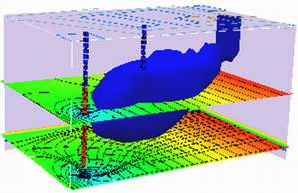F23 Exercise Set 2¶
LAST NAME, FIRST NAME
R00000000
Purpose :¶
Apply selected analytical models for conservative (non-reactive) transport
Problem 1 (Problem 6-1, pg. 567)¶
Chloride (\(Cl^{-}\)) is injected as a continuous source into a 1-D column 50 centimeters long at a seepage velocity of \(10^{-3}~\frac{cm}{s}\). The effluent concentration measured at \(t=1800~s\) from the start of the injection is \(0.3\) of the initial concentration, and at \(t=2700~s\) the effluent concentration is measured to be \(0.4\) of the initial concentration.
Determine:
Sketch the system.
The longitudinal dispersivity.
The dispersion coefficient.
The volumetric flow rate through the column.
# Enter your solution below, or attach separate sheet(s) with your solution.
Problem 2 (Problem 6-2, pg. 567)¶
Chloride (𝐶𝑙−) is injected as a continuous source into a 1-D column. The system has Darcy velocity of \(5.18 \times 10^{-3}~\frac{in}{day}\), a porosity of \(n=0.30\), and longitudinal dispersivity of \(5 m\).
Determine:
Sketch the system.
The ratio \(\frac{C}{C_0}\) at a location 0.3 meters from the injection location after 5 days of injection.
The ratio \(\frac{C}{C_0}\) at a location 0.3 meters from the injection location after 5 days of injection, if the dispersivity is 4 times larger (\(20 m\)).
Comment on the difference in results.
# Enter your solution below, or attach separate sheet(s) with your solution.
Problem 3 (Problem 6-3, pg. 587)¶
The estimated mass from an instantaneous release of benzene is \(107 \frac{kg}{m^2}\) of a 1-D aquifer system. The aquifer has a seepage velocity of \(0.03 \frac{in}{day}\) and a longitudinal dispersion coefficient of \(9 \times 10^{-4}\frac{m^2}{day}\)
Determine:
Sketch the system.
Plot a concentration profile at \(t = 1~\text{year}\) for \(x = 0\) to \(x = 50\) inches, in 1-inch increments.
Plot a concentration history at \(x=v\times (1~\text{year})\) (this value stays constant) for \(t = 0\) to \(t = 2 \) years in \(\frac{1}{12}\)-year increments.
The maximum concentration at \(t = 1~\text{year}\) and its location.
# Enter your solution below, or attach separate sheet(s) with your solution.
